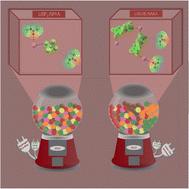深共晶电解质的分子水平非均质性
IF 2.9
3区 化学
Q3 CHEMISTRY, PHYSICAL
引用次数: 0
摘要
近年来,深共晶电解质(Deep共晶electrolyte, dee)作为下一代(锂)电池的有前景的化合物获得了发展势头。然而,分子水平性质与宏观性能之间的联系尚不清楚。在这里,我们通过分子动力学模拟,详细研究了几个简单的dei,它们是用氢键(HB)供体n -甲基乙酰胺(NMA)和三种不同的常见锂盐中的一种:LiBF4、LiDFOB和LiBOB,它们的摩尔比都是1:4。通过改变阴离子的大小和对称性,我们观察到不同的分子水平异质性(MLH),反映了局部结构和配位以及动态无序的差异,特别是HB网络的异质性。阴离子越不对称、越大,HB网络越局域化,这也影响了离子配对和聚类。从动力学的角度来看,由于较大的阴离子和局域化的HB网络造成的空间位阻,具有较大MLH的dei表现出较慢的离子自扩散。总的来说,无论是MLH和HB网络,dei的固有特性,必须适当平衡,以允许足够的离子运输。本文章由计算机程序翻译,如有差异,请以英文原文为准。

Molecular-level heterogeneity in deep eutectic electrolytes
Deep eutectic electrolytes (DEEs) have in recent years gained momentum as prospective compounds for next-generation (lithium) batteries. Yet, the connection between molecular-level properties and macroscopic performance of DEEs is poorly understood. We have here, by molecular dynamics simulations, studied in detail a few simple DEEs created using the hydrogen bond (HB) donor N-methyl-acetamide (NMA) and one of three different common lithium salts: LiBF4, LiDFOB, and LiBOB, all in a 1 : 4 molar ratio composition. By altered anion size and symmetry, we observe varying molecular-level heterogeneity (MLH), reflecting differences in local structure and coordination as well as dynamic disorder, and especially the heterogeneity of the HB network. The HB network becomes more localized the more asymmetric and larger the anion is, which also affects the ion-pairing and aggregation of the DEEs. From a dynamic point of view, DEEs with larger MLH show slower ion self-diffusion, due to steric hindrances caused by the larger anions and the localized HB network. Overall, both the MLH and the HB network, inherent properties of DEEs, must be properly balanced to allow for adequate ion transport.
求助全文
通过发布文献求助,成功后即可免费获取论文全文。
去求助
来源期刊

Physical Chemistry Chemical Physics
化学-物理:原子、分子和化学物理
CiteScore
5.50
自引率
9.10%
发文量
2675
审稿时长
2.0 months
期刊介绍:
Physical Chemistry Chemical Physics (PCCP) is an international journal co-owned by 19 physical chemistry and physics societies from around the world. This journal publishes original, cutting-edge research in physical chemistry, chemical physics and biophysical chemistry. To be suitable for publication in PCCP, articles must include significant innovation and/or insight into physical chemistry; this is the most important criterion that reviewers and Editors will judge against when evaluating submissions.
The journal has a broad scope and welcomes contributions spanning experiment, theory, computation and data science. Topical coverage includes spectroscopy, dynamics, kinetics, statistical mechanics, thermodynamics, electrochemistry, catalysis, surface science, quantum mechanics, quantum computing and machine learning. Interdisciplinary research areas such as polymers and soft matter, materials, nanoscience, energy, surfaces/interfaces, and biophysical chemistry are welcomed if they demonstrate significant innovation and/or insight into physical chemistry. Joined experimental/theoretical studies are particularly appreciated when complementary and based on up-to-date approaches.
 求助内容:
求助内容: 应助结果提醒方式:
应助结果提醒方式:


